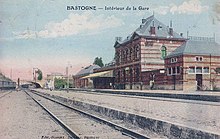Libramont – St Vith railway line
| Libramont – St Vith | |||||||||||||||||||||||||||||||||||||||||||||||||||||||||||||||||||||||||||||||||||||||||||||||||||||||||||||||||||||||||||||||||||||
|---|---|---|---|---|---|---|---|---|---|---|---|---|---|---|---|---|---|---|---|---|---|---|---|---|---|---|---|---|---|---|---|---|---|---|---|---|---|---|---|---|---|---|---|---|---|---|---|---|---|---|---|---|---|---|---|---|---|---|---|---|---|---|---|---|---|---|---|---|---|---|---|---|---|---|---|---|---|---|---|---|---|---|---|---|---|---|---|---|---|---|---|---|---|---|---|---|---|---|---|---|---|---|---|---|---|---|---|---|---|---|---|---|---|---|---|---|---|---|---|---|---|---|---|---|---|---|---|---|---|---|---|---|---|
| Course book range : | L 42 | ||||||||||||||||||||||||||||||||||||||||||||||||||||||||||||||||||||||||||||||||||||||||||||||||||||||||||||||||||||||||||||||||||||
| Gauge : | 1435 mm ( standard gauge ) | ||||||||||||||||||||||||||||||||||||||||||||||||||||||||||||||||||||||||||||||||||||||||||||||||||||||||||||||||||||||||||||||||||||
|
|||||||||||||||||||||||||||||||||||||||||||||||||||||||||||||||||||||||||||||||||||||||||||||||||||||||||||||||||||||||||||||||||||||
The Libramont – St Vith line (called Spoorlijn 163 ) was an approximately 80-kilometer-long line in the Belgian provinces of Liège and Luxembourg that was in operation until the mid-1990s .
route
The route begins at Libramont train station (km 0.0) and crosses the scenic Ardennes along its entire length . The most important intermediate stations were Bastogne Süd (km 28.7), Bourcy (km 39.0) and Gouvy (on the Luxembourg – Spa line , part of the rail link from Liège to Luxembourg). The end point Sankt Vith (km 79.0) is on the Vennbahn and Westeifelbahn , from Bastogne Süd there was a connection to Wiltz in Luxembourg.
history
The first section, put into operation on November 15, 1869, was a simple connection from Bastogne to Libramont station on the existing Namur – Luxembourg line . The line was extended in the direction of Limerlé in 1884, Gouvy followed in 1885, which enabled a connection to the Trois Ponts – Luxemburg route.
After the outbreak of the First World War , an extension line from Gouvy to St. Vith, which was connected to the German rail network, was built to the east. In addition, the Libramont – Gouvy section has been expanded to two tracks. This was intended to improve the transport of military goods and troops towards northern France.
German construction companies built the approximately 21-kilometer stretch between Gouvy and St. Vith on two tracks, with fixed engineering structures for later use in peace. In addition to four viaducts, extensive earthworks were required. Up to 8,000 workers and 134 light rail locomotives were used. Rail operations began on April 2, 1917.
After the end of the war and the handover of the Vennbahn to Belgium, traffic on this route and its connections slackened considerably. In the 1930s the line was dismantled on a track . On May 10, 1940, the first day of the western campaign , troops of the Wehrmacht special unit Brandenburger were deployed to thwart road bridges and railway bridges (e.g. the railway bridge near Wiesenbach) from being blown up.
From 1940 to 1944 the route was heavily traveled. The station was destroyed in the bombing of Sankt Vith on August 9, 1944; this meant the end of the Y Mailust – St Vith section. The suspension of the section Gouvy – Maldingen – Y Mailust in passenger traffic followed on May 18, 1952, the Gouvy – Maldingen freight transport was maintained until 1963.
Gradually the route became unprofitable. On June 3, 1984, the section Bastogne Nord – Bourcy – Gouvy and all stations between Libramont and Bastogne Nord were shut down by the newly introduced IC-IR plan of the Belgian State Railways (SNCB). The remaining passenger service Libramont – Bastogne Nord was "temporarily" switched to buses on May 22, 1993 (until today).
In 1998 the tracks between Bastogne and Gouvy were dismantled. The substructure received an asphalt road surface and has since been a route (line 163) of the RAVeL network for pedestrians and cyclists.
The rails between Libramont and Bastogne followed in the spring of 2000, but the gravel bed, bridges, most of the level crossings and some of the signals were retained. There have been investigations by the SNCB to bring this section back into operation, but no efforts have been made to implement it. However, the reopening of the railway line is included in the development plan for rail transport in Wallonia presented in 2011. There are still no concrete steps (as of mid-2012) and the city of Bastogne is acting passively. Infrabel , the current operator of the Belgian rail network, is committed to maintaining the engineering structures. In 2012 a first flyover was renewed. This could also serve to use the route as a RAVeL route .
Web links
Individual evidence
- ^ A b Hans Schweers, Henning Wall: Railways around Aachen: 150 years of the international route Cologne - Aachen - Antwerp . Verlag Schweers + Wall, Aachen 1993, ISBN 3-921679-91-5 , p. 1178
- ↑ Etienne Verhoeyen (2011): Spionnen aan de achterdeur: de Duitse Abwehr in België, 1936-1945 , p. 282 ( online ).
- ↑ http://www.rail.lu/lignesbe/163.html
- ↑ www.dhnet.be
- ↑ www.dhnet.be
- ↑ www.amisdurailhalanzy.be


